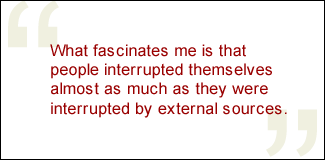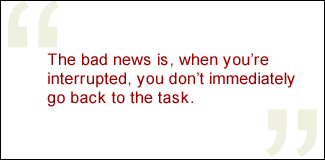It's discouraging to put in a busy 10-hour day, yet feel that you haven't accomplished anything. From constant e-mails and phone calls to coworkers with quick questions that take all morning, it sometimes seems like the single most prominent part of work is interruption.
 |
Well, you're right, probably more so than you realize. Gloria Mark, Ph.D., associate professor at the Donald Bren School of Information and Computer Sciences at the University of California, Irvine, and a leading expert on work, researched workplace interruptions and came to a fascinating conclusion: We don't have work days -- we have work minutes that last all day.
Dr. Mark researches a number of work-related topics. Some are rather exotic -- designing and evaluating collaborative systems, for example, or developing and evaluating technologies to improve "virtual co-location." But much of it is the stuff that that affects everyday workers every day -- multitasking, human-computer interaction, workplace communities, offshore sourcing of knowledge work, why people really read e-mail ("From a cost-benefit point of view, in terms of worker time," she says, "e-mail does not pay off."). But in all her work, including her current Fulbright scholarship research in Berlin, she's uncovering truisms about the way work works, and how to make it work better.
Surprisingly, some of her discoveries are utterly counterintuitive -- for example, cubicle dwellers get interrupted less often, and people are as likely to interrupt themselves as be interrupted. Others confirm what workers have suspected for years -- for instance, if interruptions make you crazy, stay out of management. In this interview, Dr. Mark discusses how much time we really get to spend on work, what really is interrupting us, and why interruptions may actually be beneficial. But read fast -- the phone is going to ring any second now.
GMJ: Tell me about your research on work interruptions.
Dr. Mark: In our study, we observed for a half day, then we shadowed 36 managers, financial analysts, software developers, engineers, and project leaders for three days. We literally followed people around all day and timed every event [that happened], to the second. We defined an event as the amount of time that people spent in continuous uninterrupted use of a device or an interaction with other people. That meant a telephone call, working on a document, typing an e-mail, or interacting with someone who came into their cubicle.
What we found is that the average amount of time that people spent on any single event before being interrupted or before switching was about three minutes. Actually, three minutes and five seconds, on average. That does not include formal meetings, because we figured if they were in a formal meeting, they were prisoners at the meeting, right? They couldn't leave or switch activities. So we didn't count that. Then we looked at [use of] devices, working on a PC, the desk phone, using any kind of paper document, using a cell phone. We found the average amount of time that people spent working on a device before switching was 2 minutes and 11 seconds.
You think you sit at your PC for a long time, but it's not true. You usually sit at it briefly before you switch to something else. You're interrupted by a person, by a phone call, or you do something on paper.
GMJ: How come this doesn't make us crazy?
Mark: I don't know. I guess the flipside is that somehow people are able to do this. That's what's remarkable.
GMJ: Doesn't getting yanked from one project to another destroy concentration?
Mark: That's what we wondered. We thought, okay, three minutes on any event before switching is maybe not so bad if it's the same project. So we took the events and assigned them into their associated projects. But we called it a "working sphere" because "project" has a limited connotation, and a working sphere is a broader idea. Anything where there's a common goal, there's a certain group of people involved with it, there are certain resources attached to it, it has its own time framework and its own deadline, is a working sphere. So we assigned these events to the working sphere, and then we measured how often people switched working spheres. Guess what we found?
GMJ: I bet that people weren't spending all day in a working sphere.
Mark: First, we found that each person worked on an average of 12.2 different working spheres every day. We also found that they switched working spheres, on average, every 10 minutes and 29 seconds. But then we thought, not all interruptions are the same. So we went through the data and removed all interruptions that were two minutes or less. Two minutes is fairly short time and for anything under two minutes, people should be able to go back and reorient to what they were doing. So even when we took out what we call "non-significant" interruptions, we find that people still worked 12 minutes and 18 seconds in a working sphere before switching.
GMJ: But were they switching tasks of their own volition?
Mark: Ah, that's a very good question! We looked at interruptions, and not all interruptions are the same. Some interruptions are from external sources. A person comes in, or your e-mail signal comes on, or the phone rings, or people chat through the cubicle wall to you. Those are external interruptions. But there are also internal interruptions; for whatever reason, people interrupt themselves of their own volition and switch to something else.
And what fascinates me is that people interrupted themselves almost as much as they were interrupted by external sources. They interrupted themselves about 44% of the time. The rest of the interruptions were from external sources.
Managers experienced far more external interruptions than internal interruptions. That was a significant difference. Managers have a huge network of people who come in and interrupt them. Analysts and developers are involved with a smaller network of people, so they have fewer external interruptions. But the fact remains that they still have a lot of internal interruptions.
GMJ: What provokes an internal interruption?
Mark: We don't know, but I have some ideas. When I was working on the paper for this study, I had a three-hour block of time one day, and that's just amazing for me. I was so happy; I closed the door to my office at the risk of being socially unacceptable. I thought, I have three hours -- I can do some thinking, some real work! And what I proceeded to do was all those little tiny tasks that had been building up, all the little things that I hadn't had a chance to get to. And before I knew it, the three hours were up, and I hadn't done anything on the paper. So why did I do that? I interrupted myself. I kept interrupting myself. One theory I have is that maybe it was instant gratification. I could get it done and be happy because, my gosh, I finally got things out of the way.
 |
GMJ: How long does it take to get back to work after an interruption?
Mark: There's good news and bad news. To have a uniform comparison, we looked at all work that was interrupted and resumed on the same day. The good news is that most interrupted work was resumed on the same day -- 81.9 percent -- and it was resumed, on average, in 23 minutes and 15 seconds, which I guess is not so long.
But the bad news is, when you're interrupted, you don't immediately go back to the task you were doing before you were interrupted. There are about two intervening tasks before you go back to your original task, so it takes more effort to reorient back to the original task. Also, interruptions change the physical environment. For example, someone has asked you for information and you have opened new windows on your desktop, or people have given you papers that are now arranged on your desk. So often the physical layout of your environment has changed, and it's harder to reconstruct where you were. So there's a cognitive cost to an interruption.
GMJ: Do different kinds of interruptions, e-mail versus the phone versus a person, make it harder to reorient to the task?
Mark: It's not so much the medium that was used for the interruption, it's more the content. Interruptions could be beneficial or hindering. When they were hindering, when an interruption was from a working sphere that was not the one that people were currently involved in, the people we studied called them distractions. On the other hand, when they were in a working sphere, and someone interrupted with the same content as that working sphere, people called it interaction. And then it's beneficial.
GMJ: A complaint about cubicles is that the external noise makes it hard to concentrate. Did you find that?
Mark: That's interesting. Some of our people were co-located -- they were physically close to the people that they collaborate most with. Some were in offices, some were in cubicles. People who were co-located had significantly more interruptions than people whose collaborators were far apart, but they were able to work significantly longer in a working sphere before switching.
When people are co-located, they're more socially aware of the people who are near them, so they have a better sense of when not to interrupt them. So, as soon as they hear that there's a natural breaking point in a colleague's task, everyone rushes over and interrupts. Co-locators can work longer stretches, but when they're interrupted, it's like bang, bang, bang, one interruption after another. When people work in cubicles, they can hear that natural breaking point -- they know when to interrupt, but people in offices don't have that. So there's a benefit to cubicles.
GMJ: But there has to be a cost to productivity.
Mark: There must be, but we don't know what [it is]. But we know an interaction, a beneficial interruption, helps productivity. Co-located people monitor the environment remarkably well, and that aids productivity. I did a study on extreme collaboration with NASA engineers. We studied a group of 17 engineers who were put into the same room to design a spacecraft, and they were able to reduce the amount of time to design a spacecraft from six months down to nine hours. One reason is because they were able to catch mistakes immediately, and they didn't have to redo the design over and over. It's not something technology could have done.
GMJ: How can technology help?
Mark: The paradox of information technology is that IT is designed to support individual activities -- opening up a Word document, using an e-mail, or even just [answering] the telephone. All of these activities are separate, and the burden falls on the user to integrate them. But we don't work that way. We work at the level of the working sphere.
It would be great if technology could integrate all those individual events and pieces of information into a cohesive place. There's got to be a way to be able to use technology to broadcast when you're interruptible and when you're not. The trade-off is privacy. There has to be a certain level of granularity about what can be broadcast to people so that they don't feel their privacy has been invaded, and yet they can allow themselves to have good interruptions.
But still, I think that users should protest. I mean, we've had to adapt to unnatural systems, right? It's time technology adapted to us.
-- Interviewed by Jennifer Robison
